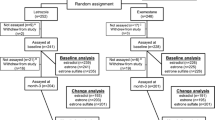Abstract
Background: Tamoxifen and fenretinide combination therapy has been shown to be an active treatment regimen in metastatic breast cancer patients. This pilot study sought to determine whether the addition of fenretinide to tamoxifen would be associated with antitumor activity in metastatic breast cancer patients who had been previously treated with tamoxifen or who had hormone receptor negative disease. The effect of this therapy on circulating plasma transforming growth factor‐beta (TGF‐β) levels and serum lipids was also examined.
Patientsand Methods: Thirty‐one patients were treated with tamoxifen (20mg po daily), and fenretinide (400mg po daily with a 3‐day drug holiday each month). Plasma TGF‐β testing was performed using isoform specific sandwich ELISA.
Results: Twenty four of the 31 patients were evaluable for an antitumor response including 14 estrogen receptor (ER) positive patients who had failed prior tamoxifen therapy, seven ER‐negative patients, and three hormone therapy naive ER‐positive patients. There were no objective antitumor responses; three patients had stable disease for 8, 8, and 24 months. Five patients (16%) discontinued therapy for toxicity (one for grade 3 skin rash and four for abnormal dark adaptation). There was a statistically significant decrease in total cholesterol (median change per patient of −13.5 mg/dl; p=0.049, a 6.5% decrease), and an increase in HDL levels (median change per patient of +18 mg/dl, p=0.0001, a 35% increase) with tamoxifen and fenretinide therapy.
TGF-β1 plasma levels were normal in 26 of 28 patients, and no changes in these levels post-treatment were demonstrated.
Conclusions: Tamoxifen and fenretinide therapy is not an active combination in ER negative metastatic breast cancer or in patients whose disease has progressed on tamoxifen. This combination had a beneficial effect on total serum cholesterol and HDL levels with no associated rise in serum triglyceride levels. The 400 mg dose of fenretinide was associated with symptomatic nyctalopia in one-third of patients making it an unsuitable dose for use in breast cancer prevention studies.
Similar content being viewed by others
References
Early Breast Cancer Trialists' Collaborative Group: Tamoxifen for early breast cancer: an overview of the randomized trials. Lancet 351: 1451–1467, 1998
De Luca LM: Retinoids and their receptors in differentiation, embryogenesis, and neoplasia. FASEB J 5: 2924–2933, 1991
Smith MA, Parkinson DR, Cheson BD, Friedman MA: Retinoids in cancer therapy. J Clin Oncol 10: 839–864, 1992
Lippman SM, Kessler JF, Meyskens FL: Retinoids as prevention and therapeutic anticancer agents. Cancer Treat Rep 71: 391–405, (Part I); 493-515 (Part II), 1987
Dowlatshari K, Mehta RG, Thomas CF, Dinger NM, Moon RC: Therapeutic effect of N-(4-hydroxyphenyl)retinamide on N-methyl-N-nitrosourea-induced rat mammary cancer. Cancer Let 47: 187–192, 1989
Moon RC, Thompson HJ, Becci PJ, Grubbs CJ, Gender RJ, Newton DL, Smith JM, Phillips SL, Henderson WR, Mullen L T, Brown CC, Sporn MB: N-(4-hydroxyphenyl)retinamide, a new retinoid for prevention of breast cancer in the rat. Cancer Res 39: 1339–1346, 1979
Ratko TA, Detrisac CJ, Dinger NM, Thomas CF, Kelloff GJ, Moon RC: Chemopreventive efficacy of combined retinoid and tamoxifen treatment following surgical excision of a primary mammary cancer in female rats. Cancer Res 49: 4472–4476, 1989
Moon RC, Kelloff GJ, Detrisac CJ, Steele VE, Thomas CF, Sigman CC: Chemoprevention of MNU-induced mammary tumors in the mature rat by 4-HPR and tamoxifen. Anticancer Res 12: 1147–1154, 1992
Modiano MR, Dalton WS, Lippman SM, Joffe L, Booth AR, Meyskens FL Jr: Phase II study of fenretinide (N-[4-hydroxyphenyl]retinamide) in advanced breast cancer and melanoma. Invest New Drugs 8: 317–319, 1990.
Cobleigh MA, Dowlatshahi K, Deutsch TA, Mehta RG, Moon RC, Minn F, Benson AB III, Rademaker AW, Ashenhurst JB, Wade JL, Walker J: Phase I/II trial of tamoxifen with or without fenretinide, an analog of vitamin A, in women with metastatic breast cancer. J Clin Oncol 11: 474–477, 1993
Torrisi R, Parodi S, Fontana J, Pensa F, et al.: Effect of Fenretinide on plasma IGF-1 and IGFBP-3 in early breast cancer patients. Int J Cancer 76: 787–790, 1998
Torrisi R, Pensa F, Fontana V, Costa A, Decensi A: The metabolite N-40 methoxyphenylretinamide is a major determinant of fenretinide induced decline of plasma insulin-like growth factor-1. Eur J Cancer 31A: 420–421, 1995
Decensi A, Formelli F, Torrisi R, Costa A: Breast cancer chemoprevention: Studies with 4-HPR alone and in combination with tamoxifen using circulating growth factors as potential surrogate endpoints. J Cell Biol 17G: 226–233, 1993
Pollak M, Costantino J, Polychronakos C, Bauer SA, Guyda H, Redmond C, Fisher B, Margolese R: Effect of tamoxifen on serum insulin-like growth factor I levels in Stage I breast cancer patients. J Natl Cancer Inst 82: 1693–1697, 1990
Knabbe C, Lippman ME, Wakefield LM, Flanders KC, Kasid A, Derynck R, Dickson RB: Evidence that transforming growth factor-b is a hormonally regulated negative growth factor in human breast cancer cells. Cell 48: 417–428, 1987
Arteaga CL, Tandon AK, Von Hoff D, Osborne CK: Transforming growth factor B: potential autocrine growth inhibitor of estrogen receptor-negative human breast cancer cells. Cancer Res 48: 3898–3904, 1988
Glick AB, McCune BK, Abdulkarem N, Flanders KC, Lunadue JA, Smith JM, Sporn MB: Complex regulation of TGF-b expression by retinoic acid in the vitamin A deficient rat. Development 111: 1081–1086, 1992
Butta A, MacLennan K, Flanders KC, Sacks NPM, Smith I, McKinna A, Dowsett M, Wakefield LM, Sporn MB, Baum M, Colletta AA: Induction of transforming growth factor-b1 in human breast cancer in vivo following tamoxifen treatment. Cancer Res 52: 4261–4264, 1992
Rotmensz N, DePalo G, Formelli F, Costa A, Marubini E, Campa T, Crippa A, Danesini GM, Grottaglie M Delle, DiMauro MG, Filiberti A, Gallazzi M, Gozzon A, Magni A, Malone W, Mariani L, Palvarini, Perloff M, Pizzichetta M, Veronesi U: Long-term tolerability of fenretinide (4-HPR) in breast cancer patients. Eur J Cancer 27: 1127–1131, 1991
Wakefield LM, Letterio JJ, Chen T, Danielpour D, Allison RSH, Pai LH, Denicoff AM, Noone MH, Cowan KH, O'Shaughnessy JA, Sporn MD: Transforming growth factor b1 circulates in normal human plasma and is unchanged in advanced metastatic breast cancer. Clin Cancer Res 1: 129–136, 1995
Decensi A, Torrisi R, Polizzi A, Gesi R, Brezzo V, Rolando M, Rondanina G, Orengo MA, Formelli F, Costa A: Effect of the synthetic retinoid fenretinide on dark adaptation and the ocular surface. J Natl Cancer Inst 86: 105–110, 1994
Caruso RC, Zujewski J, Iwata F, Podgon MJ, Conley BA, Ayres LM, Kaiser-Kupfer MI: Effects of fenretinide (4-HPR) on dark adaptation. Arch Ophthalmol 116: 759–763, 1998
Thangaraju M, Kumar K, Gandhirajan R, Sachdanandam P: Effect of tamoxifen on plasma lipids and lipoproteins in postmenopausal women with breast cancer. Cancer 73: 659–663, 1994
Love RR, Wiebe DA, Feyzi JM, Newcomb PA, Chappel RJ: Effects of tamoxifen on cardiovascular risk factors in postmenopausal women after 5 years of treatment. J Natl Cancer Inst 86: 1534–1539, 1995
Bruning PF, Bonfrer JM, Hart AA, Bakker MD, Linders D, Loos JV, et al.: Tamoxifen, serum lipoproteins and cardiovascular risk. Br J Cancer 58: 497–499, 1988
Rossner S, Wallgren A: Serum lipoproteins and proteins after breast cancer surgery and effects of tamoxifen. Atherosclerosis 53: 339–346, 1984
Wander HE: Changes in the serum lipoprotein under tamoxifen (Abstract). Second International Symposium on Antihormones in Breast Cancer, Berlin, October 21-24, 1984
Kong FM, Anscher MS, Murase T, Abbott BD, Inglehart JD, Jirtle RL: Elevated plasma transforming growth factor-beta levels in breast cancer patients decrease after surgical removal of the tumor. Ann Surg 222: 155–162, 1995
Kopp A, Jonat W, Schmahl M, Knabbe C: Transforming growth factor b2 (TGF-b2) levels in plasma of patients with metastatic breast cancer treated with tamoxifen. Cancer Res 55: 4512–4515, 1995
Anscher MS, Peters WP, Reisenbichler H, Petros WP, Jirtle RL: Transforming growth factor b as a predictor of liver and lunger fibrosis after autologous bone marrow transplantation for advanced breast cancer. New Engl J Med 328: 1592–1598, 1993
Author information
Authors and Affiliations
Rights and permissions
About this article
Cite this article
Zujewski, J., Pai, L., Wakefield, L. et al. Tamoxifen and fenretinide in women with metastatic breast cancer. Breast Cancer Res Treat 57, 277–283 (1999). https://doi.org/10.1023/A:1006216409688
Issue Date:
DOI: https://doi.org/10.1023/A:1006216409688




